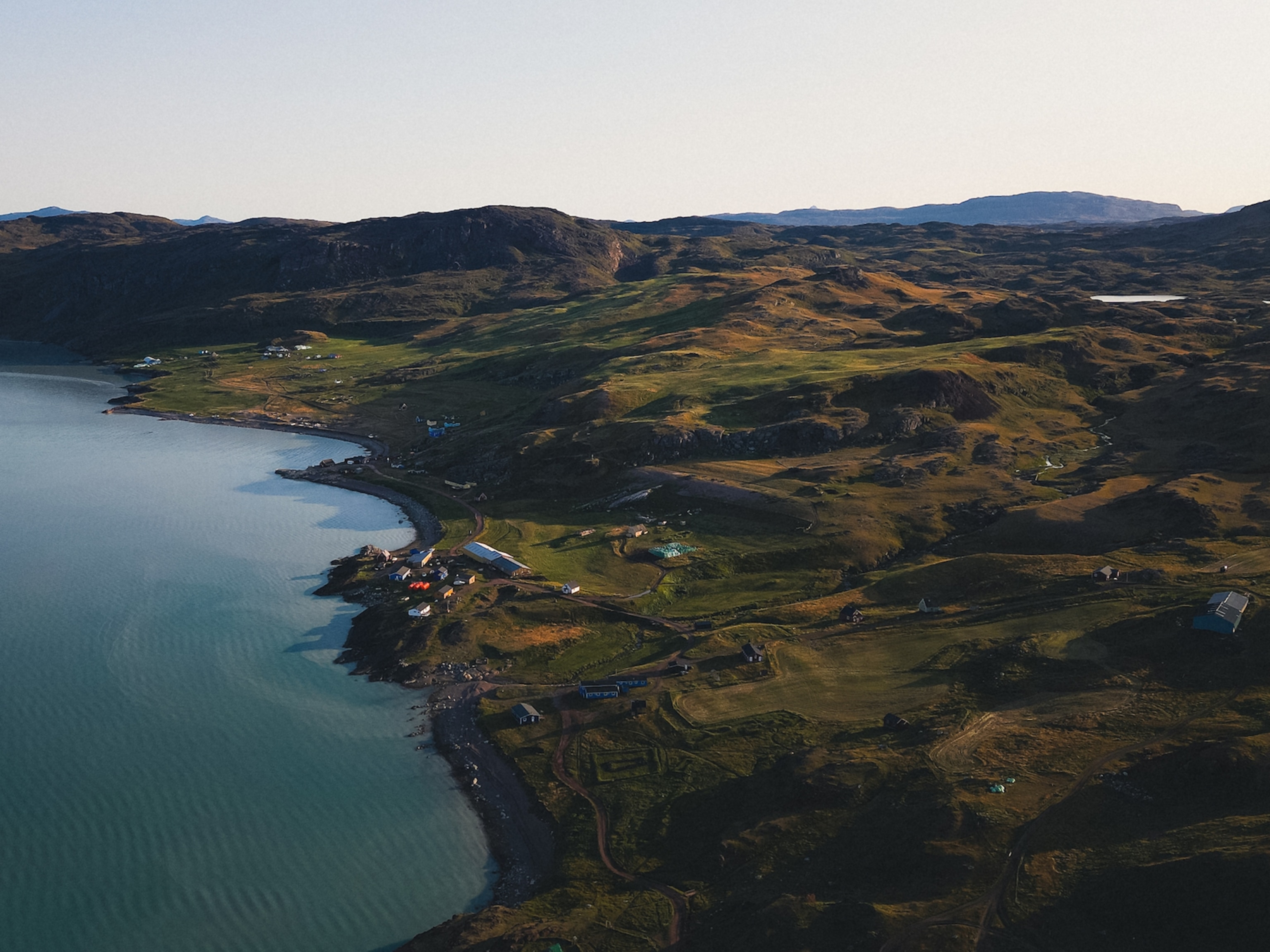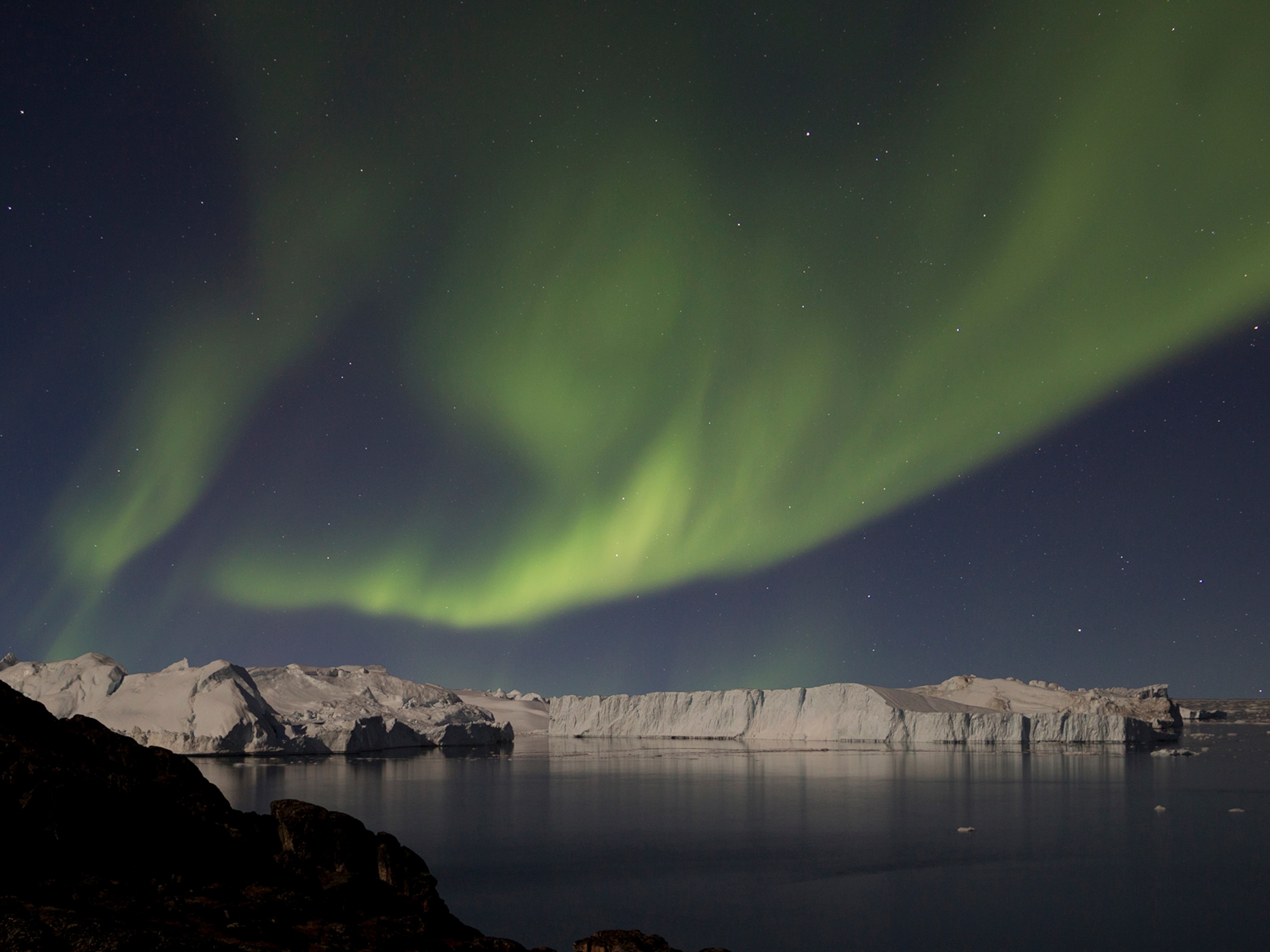
Take the plunge on a voyage into Greenland's wild southern fjords
Dotted with icebergs, abandoned Viking settlements and hardy hunting communities, the far-flung fjords of South Greenland make for an unparalleled polar cruise.
Well, at least I’m not in my underpants. “I forgot to pack my swimming trunks,” says the man behind me with a nervous laugh, crossing his hands awkwardly in front of an off-white pair of Y-fronts. I smile sympathetically and assure him nobody will notice, which is a lie but not a big one, because most people in this queue are too preoccupied with what’s coming next to notice a middle-aged man in his undies.
They know it’s going to hurt. Ahead, there’s a squeal and a splash, and a raucous cheer from the onlookers, and the line moves forward again. Another squeal, another roar, another step closer to the end. My turn comes far too soon. I’m led to the platform at the back of the ship, a thin lattice of metal above a sea that’s black, deep and very, very cold. Someone attaches a line around my waist, which the crew will use to haul me back with if I go into shock. What am I doing?! There’s an iceberg over there, for heaven’s sake. I hesitate like a child on a high board. Another second, and I definitely won’t do it. But my body unlocks and I make the leap, and then I’m gasping and cursing in the water, and scrabbling back aboard with my skin on fire, while Captain Underpants is ushered forward for his own moment of reckoning.
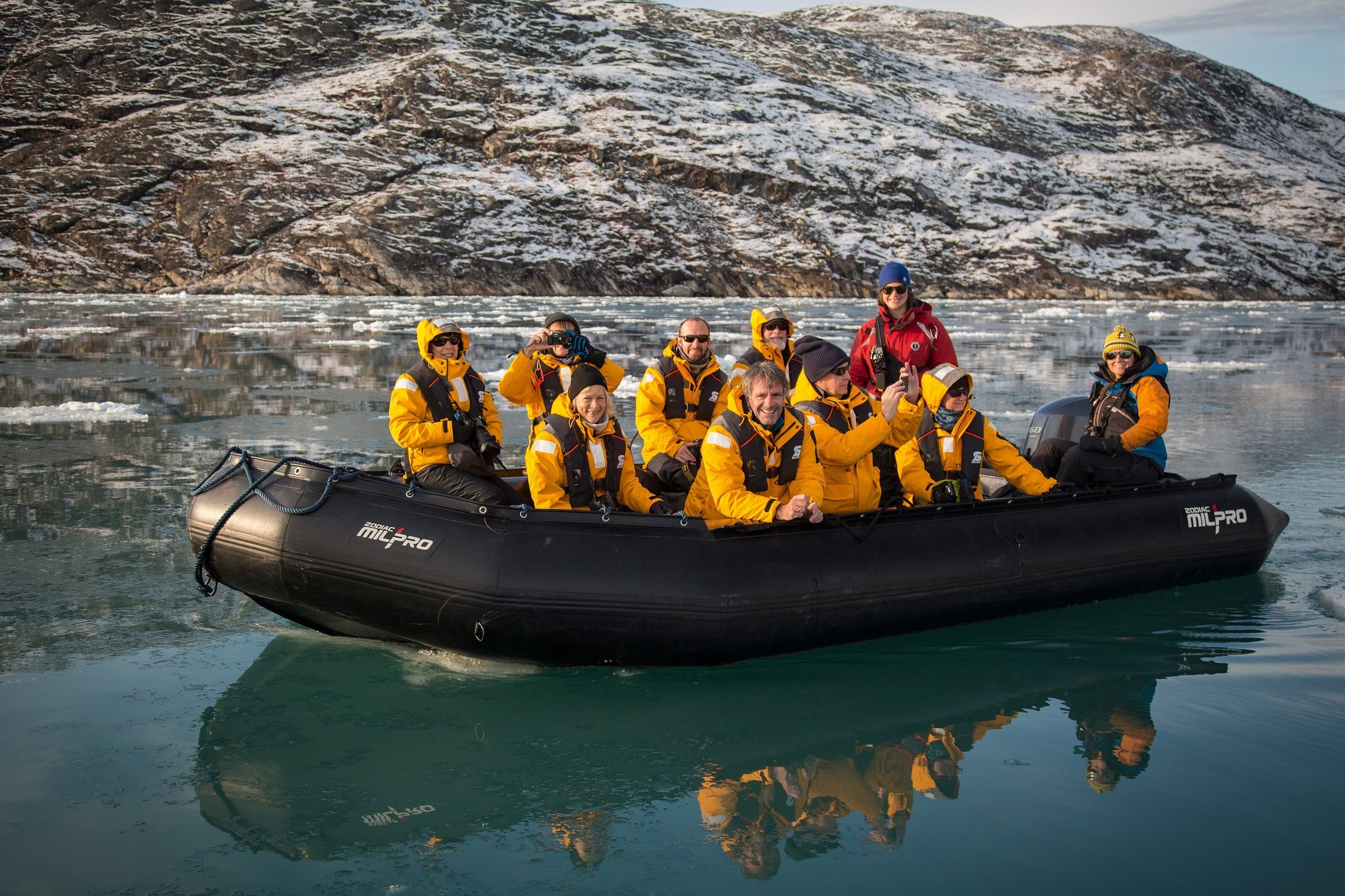
The Polar Plunge has become a rite of passage on trips like these, a reinvented walking of the plank that concludes with fluffy dressing gowns, shots of vodka and triumphant high-fives between those who dare to jump. And, of course, the symbolism is unmistakable: ‘immersive’ experiences are what a week-long journey into the fjords of South Greenland is all about.
That’s not to say this is a trip for Bear Grylls types, though. The Ultramarine is the newest ship in Quark Expeditions’ fleet and has no shortage of comforts, from a spa offering seaweed treatments to a Panorama Lounge, where you can sip martinis while admiring views through an arc of floor-to-ceiling glass. But such luxuries are a sideshow; topping the bill for passengers on the Ultramarine are forays into the wilderness that other ships can’t reach.
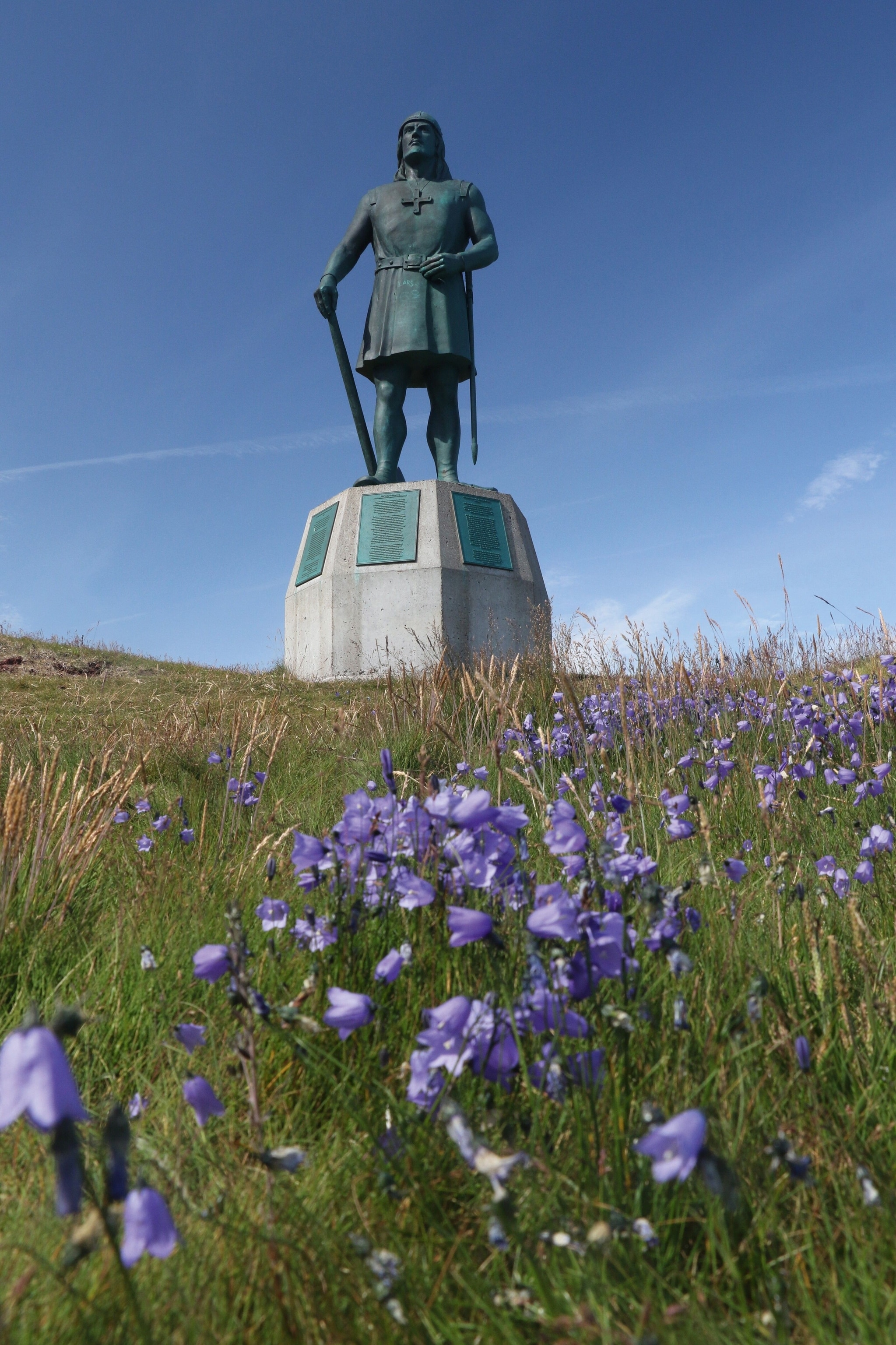
Setting the stage
“Prepare to be taken to the beating heart of Greenland,” urges expedition leader Alison Gordon, during one of our first morning briefings. She has an ear for the theatrical, and her statement is met with a chorus of whoops from the Americans among the 130 passengers. The Brits clap politely. There follows a flurry of information and advice: dress in layers, wear your allocated Muck Boots, use the forearm-to-forearm sailor’s grip when being helped into the rigid inflatable Zodiac boats. Respect local communities, don’t take photos through their windows, do have an open mind, don’t pet arctic dogs, do remember your waterproof trousers, don’t rearrange stacks of stones if you see them — they might be signposts of some sort.
Most importantly, be flexible. “You’ve seen the trip itinerary? Well, go and tear it up!” says Alison with relish. “We’re at the mercy of the elements, so we must grab opportunities where they come.” Prowling the stage of the ship’s Ambassador Theatre, she sweeps the audience with her eyes. “Ladies and gentlemen, we’re scrapping the Zodiac activities this afternoon” — pause for groans of disappointment — “because the charts show a window of clear weather” — pause for puzzled looks. “Instead” — an agonising, pregnant pause — “we’re going to get you up in the sky!” And with a final flourish, Alison raises her fist as the room dissolves into prolonged whooping and slightly more vigorous polite clapping.
Among the Ultramarine’s bells and whistles are two H145 twin-engine helicopters. I join six other passengers on the top deck to be weighed before boarding. “It’s for our fuel calculations,” explains a crew member apologetically as we take turns at the scales. “Don’t worry, we won’t post the figures on social media.”
Our pilot, Jonny Mutch, is ex-military and has a steady, straight-backed air of confidence that’s reassuring when you’re strapped in for take-off from a floating helipad in the back of beyond. “I like to imagine you’re all holding gin and tonics when I take off,” Jonny reveals soothingly through our earphones, striking a patricianly tone that’s more ‘top hat’ than Top Gun. The engine whines louder, the thud of the rotor blades hammering through my chest, and we lift from the ship — up, up, up — before banking away to our left with silky smoothness. “Not a drop spilt,” Jonny declares with satisfaction, his voice a cocktail of cut glass and honey.
The ship has moored in a fjord called Prince Christian Sound, which cuts inland from the south-eastern edge of Greenland. Now, from 4,500ft, we get a sense of the sheer scale of what’s around us. Leaving the sea behind, we follow the path of a glacier through steep valleys and vast, dark peaks. For all its beauty, this isn’t the nature of love poems; the glacier is scratched and gashed as though fresh from a cat fight. Boulders are strewn about like the rubble of destroyed buildings. The mountains are hard and jagged, with nothing of the pastoral to soften them. This is nature battle-hardened by a long war between rock and ice — a grinding, gouging, gnawing struggle over thousands of years that’s scraped the flesh from the landscape.
Next morning, we’re hitting the water again but, this time, we’re shrink-wrapped in dry suits and safely packed into kayaks. There are 10 of us in the group, and I’m paired with an indomitable septuagenarian from Bristol called Jo. I like her instantly. “Are you sure you’re paddling back there?” she calls over her shoulder, her own paddle lying unused across her lap as she takes photos of the shoreline. “We don’t seem to be getting anywhere!”
An expedition is as much about the people as the places. There’s a wide range on this trip, from pensioners and young couples to families with teenage children. Jo is travelling solo on her fifth polar expedition, and she certainly knows how to squeeze the best from an excursion. On her instructions, I paddle us to the base of a photogenic waterfall, and then along the edge of the fjord in energetic pursuit of a northern wheatear, tail flashing white as it flits ahead. All the while, my arms stinging with lactic acid, Jo entertains me with glimpses of the world through her eyes. “In Scotland, they call that bird a ‘white arse’,” she says as she sits back and enjoys the chase. “A much better name, don’t you think?” And then, perhaps prompted by the swirl of an Arctic char in the water, she continues: “Do you like sushi? I’ve never quite seen the point of it.”
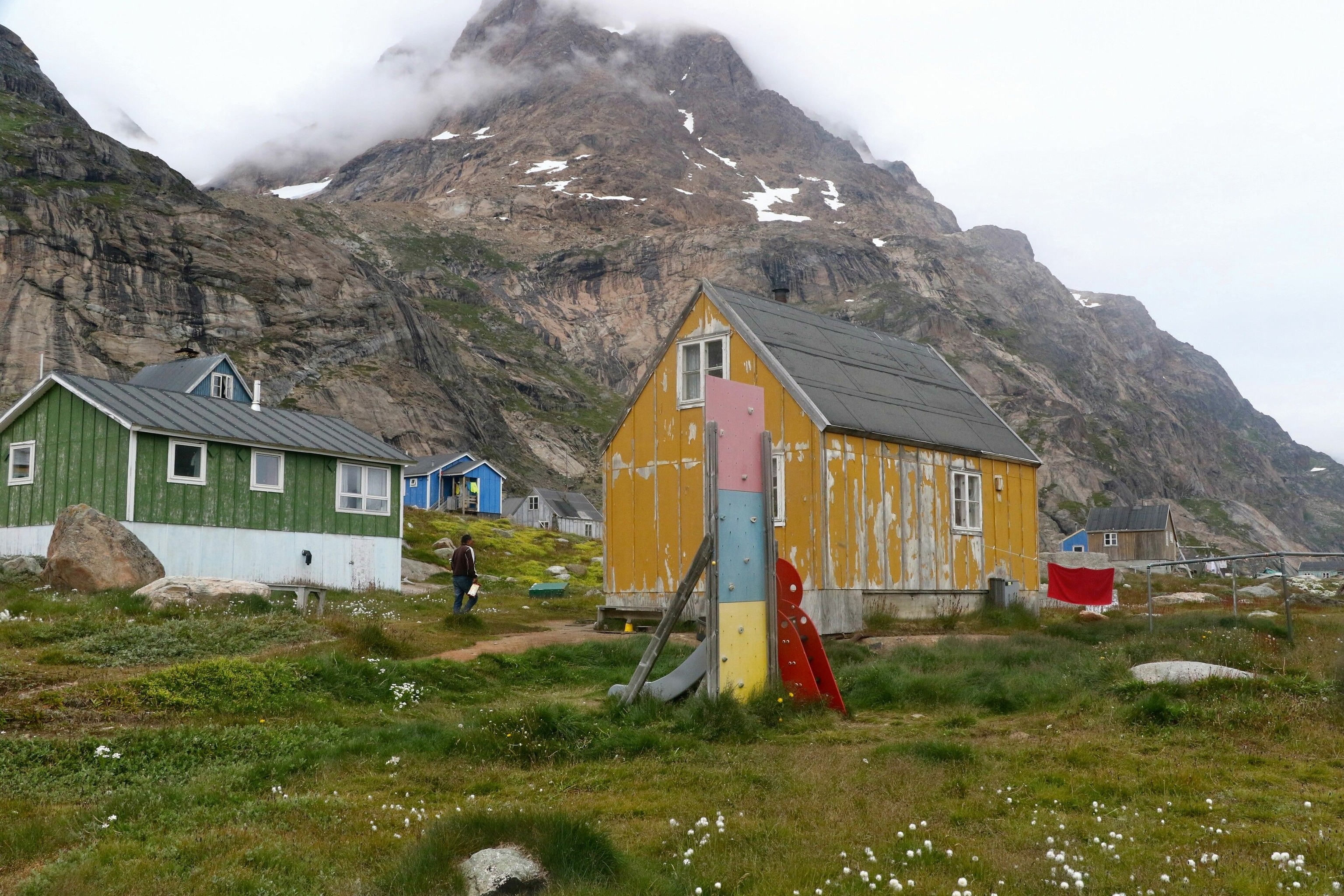
Down here, the mountainsides seem no less forbidding than they had from the helicopter, but I now see that the lower slopes pop with the vivid colours of life.
Blue harebells nod in patches above the shoreline and Arctic fireweed flares red. From this angle, nature seems more creative than destructive. We paddle past an iceberg that looks like a Henry Moore sculpture, a perfect hole through its centre, shaped and sanded by the sea. When we reach the end of the fjord’s cul-de-sac, we’re met by a gaggle of rocky cones stretching back from the water’s edge. These are drumlins, our guide, Callum Findley, tells us, formed when dirt and stones funnel to the bottom of a glacier through sinkholes in the ice. The glacier has long retreated, but the drumlins remain, some barely waist high, others the size of hills, but all so neat they seem crafted by an artist’s hand.
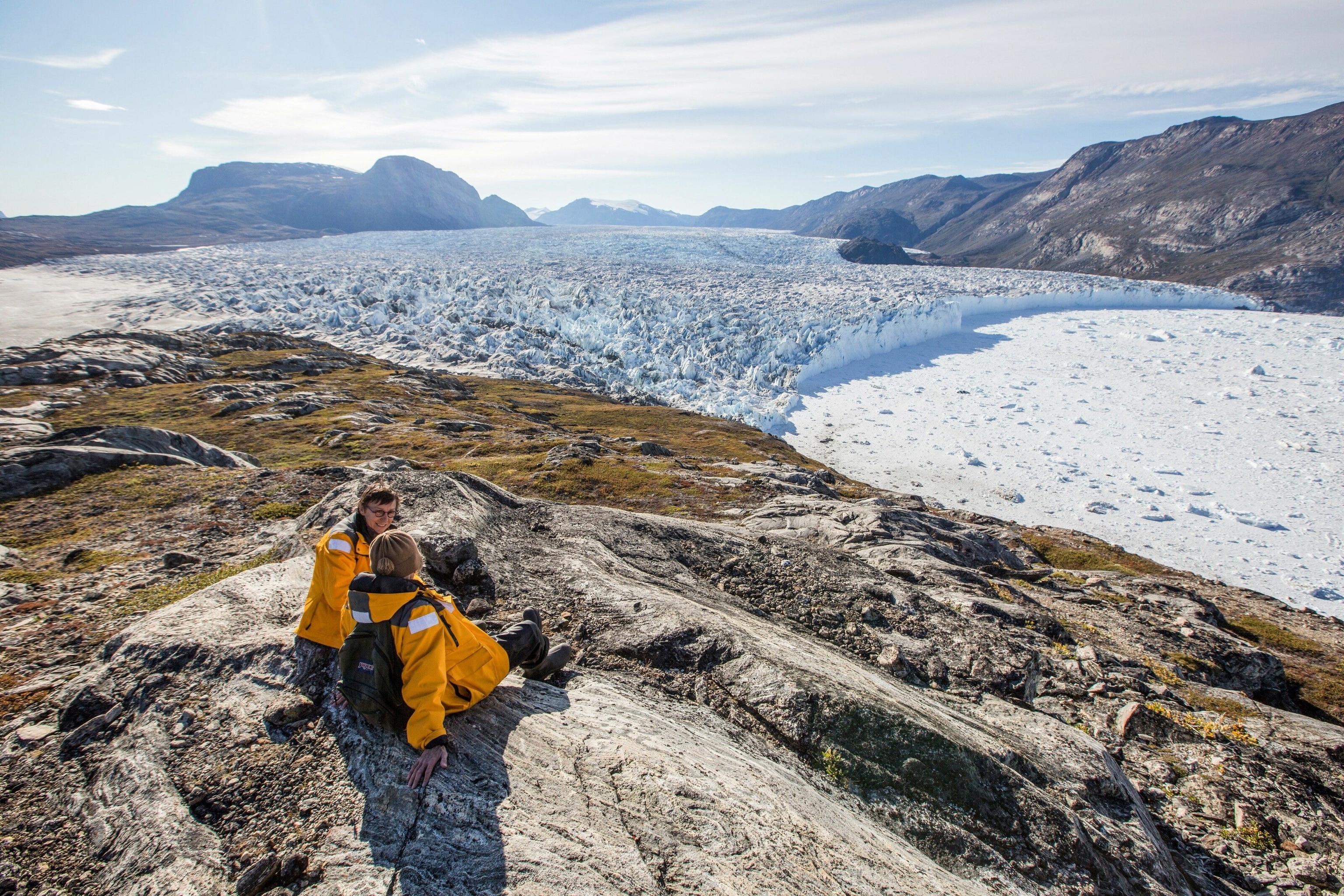
The tentacles of the Greenlandic Ice Sheet fall short of these southern fjords, and life prospers in the summer months. The following day, having been dropped off by helicopter at Tasermiut Fjord in the west, we discover the ground beneath our Muck Boots is covered with a springy mat of miniature trees, shrubs and grasses. They include dwarf birch, arctic willow and evergreen crowberry bushes, covered in purple berries that are used to make wines and liqueurs. The ankle-height trees could have been lifted from a model village, the permafrost preventing them from digging deep and growing tall. Elsewhere, the land has the look of a seabed, mint-green balls of lichen lying like anemones among the rocks. “Reindeer absolutely love those,” says our Icelandic guide, Dagny Ívarsdottir.
The guides carry guns in case of polar bears, but the animals are rarely seen this far south. In fact, few animals of any sort inhabit this region. We find the hoof print of a sheep belonging to a distant farm and the droppings of an arctic hare. Dagny shows us a dense quenelle of matted hair, the regurgitated remains of a white-tailed eagle’s meal.
But nothing moves now. Nothing except the mosquitoes — mosquito larvae thrive in the shallow ponds of the tundra. Each time we alight from a rigid inflatable or helicopter, we hastily drag mosquito nets over our heads before trooping into the wilderness like beekeepers on a team-building day out. Dagny tries to make the mosquitoes interesting rather than irritating, as they form clouds around our nets. Only the females bite, she tells us, and they’re attracted to the carbon dioxide in our breath. “So, if you want them to leave you alone,” adds Jo, “all you have to do is stop breathing.”
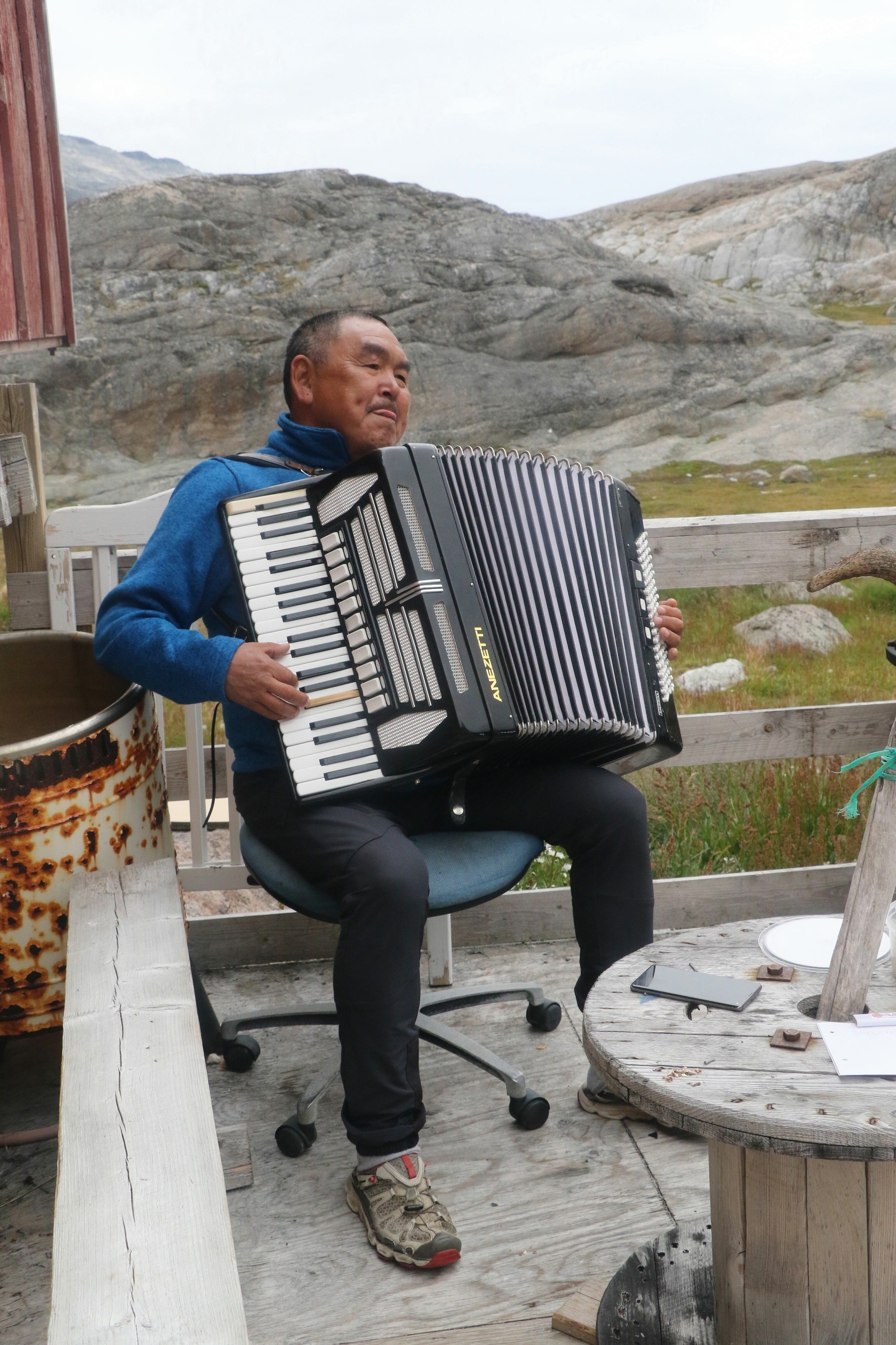
Into the village
Back on board, mealtimes are hefty spreads — but the real feast is alongside us. As the ship glides onward, its windows become screens for a monumental work of natural cinematography. Cliffs loom close, purple-grey rock streaked with black lines like congealed blood. One evening, as we exit the mouth of a fjord, a trio of turreted icebergs are caught so perfectly in a strip of late sun through the cloud that I could have been watching a scene of divine revelation in a Biblical epic.
And occasionally, just occasionally, there’s a sign of human habitation. We pass a clutch of four houses on a flat rock, and marvel at the resilience required to live in such isolation. We visit the remains of a Norse settlement called Herjolfnes, where a chieftain called Herjolf Bardsson landed in AD 985, and I picture longships emerging among the icebergs from the mist at the horizon. By the 15th century, though, the Vikings had packed up and shipped out. No one knows why. They were hardly a delicate breed but I strongly suspect they couldn’t hack the mosquitoes.
Today, around 56,000 people call Greenland home, mainly the descendants of Inuits from Alaska. But you don’t just bump into a Greenlander. This is the world’s largest island, more than 100 times bigger than Wales — indeed, so big that it officially lies north, east, south and west of Iceland, all at once. It’s the least densely populated region anywhere on the planet. However, our programme was designed in discussion with local communities, and we’ve been invited to spend our penultimate day with the around 100 or so residents of Aappilattoq.
It’s not until our rigid inflatable rounds a tongue of headland that we see the fishing village on its sheltered bay. In fact, we smell it before we see it, an odour of fish, seaweed and something oily that might be rendered blubber. A dead ring seal with blood on its snout floats next to a fishing boat at the jetty, tied to the stern with string. There’s a bucket of glassy-eyed fish heads, and various tangles of fishing nets and buoys. A wooden-shafted spear stands propped against a post.
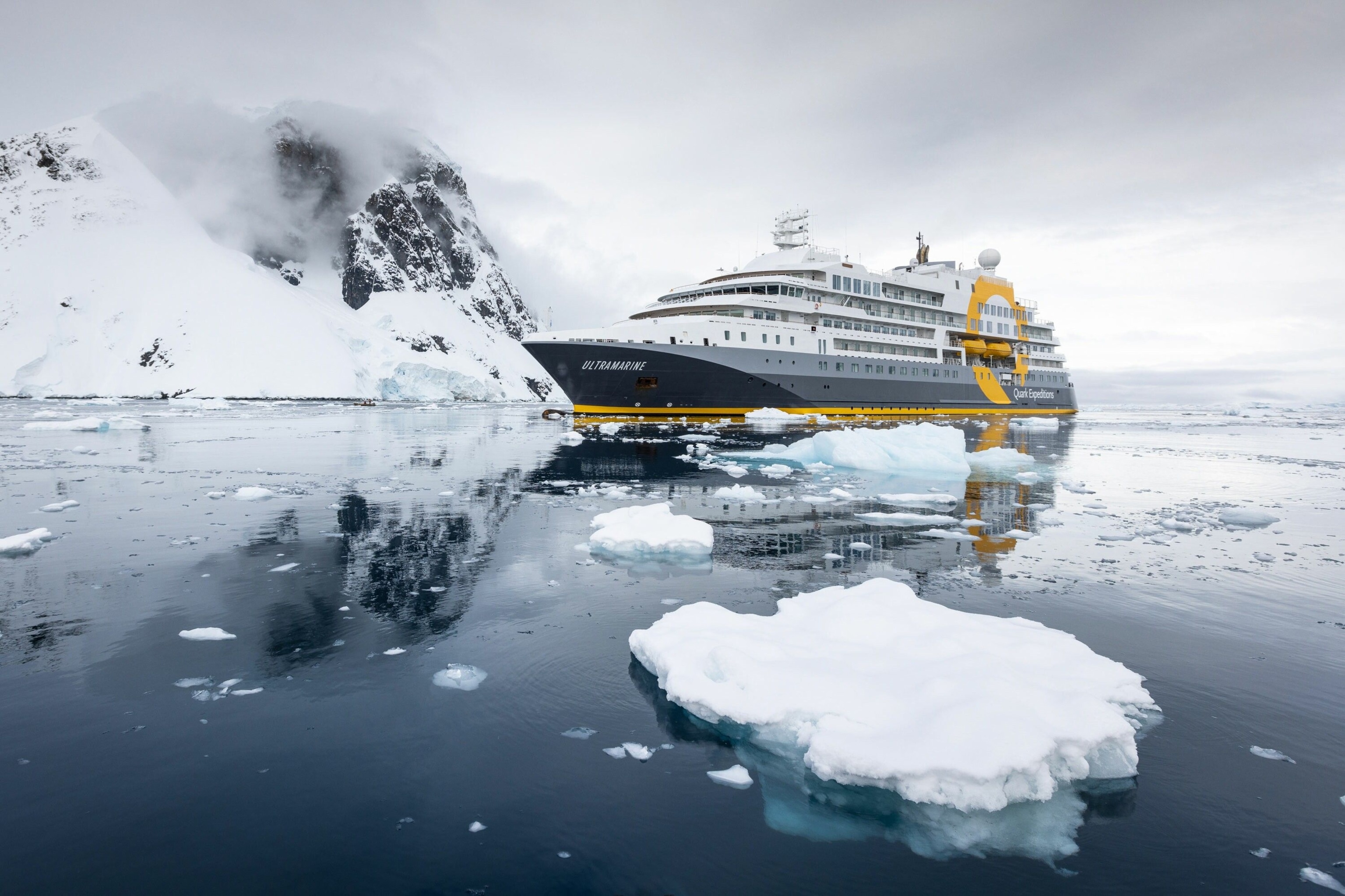
Beyond the jetty are 20 houses, with slatted wooden walls and brick chimneys above steep-pitched roofs. Each is painted blue, or red or green, and in one of them lives Themo Benjaminssen, the owner of the wooden-shafted spear. He greets us outside, a shaggy arctic dog at his heel and the pelt of a polar bear draped across a table. “You’ll get the chance to speak to the village hunter,” Alison had told us at last night’s briefing. “This might be confronting, but keep an open mind.” Yellowed claws spiral from the flattened paws of the bear skin.
“I killed this polar bear last spring, six hours from here,” says Themo, with a hint of defiance that suggests he expects disapproval from this gaggle of green tourists. There’s an awkward silence, and then a question comes. What do you do with it? “Cook and eat the meat,” Timu replies. “Everyone in the village shares the food. Sometimes other communities, too.” We watch him, processing things, deciding what we think about that, and he returns our gaze unblinkingly, thumbs hooked in his jeans. “And my granddaughter sleeps on the fur,” he adds finally, with a fond chuckle that breaks the ice.
Themo tells us his father was a hunter, and that his son will be one too. He explains hunting is strictly controlled, that he has a licence to kill a maximum of four bears and two minke whales each year, that this is hunting for subsistence, hunting done sustainably. He describes his fear while tracking a bear and his jubilation when the kill is made. We learn that polar bear tastes like lamb and that minke whales are very heavy, and that nothing — nothing — is ever wasted.
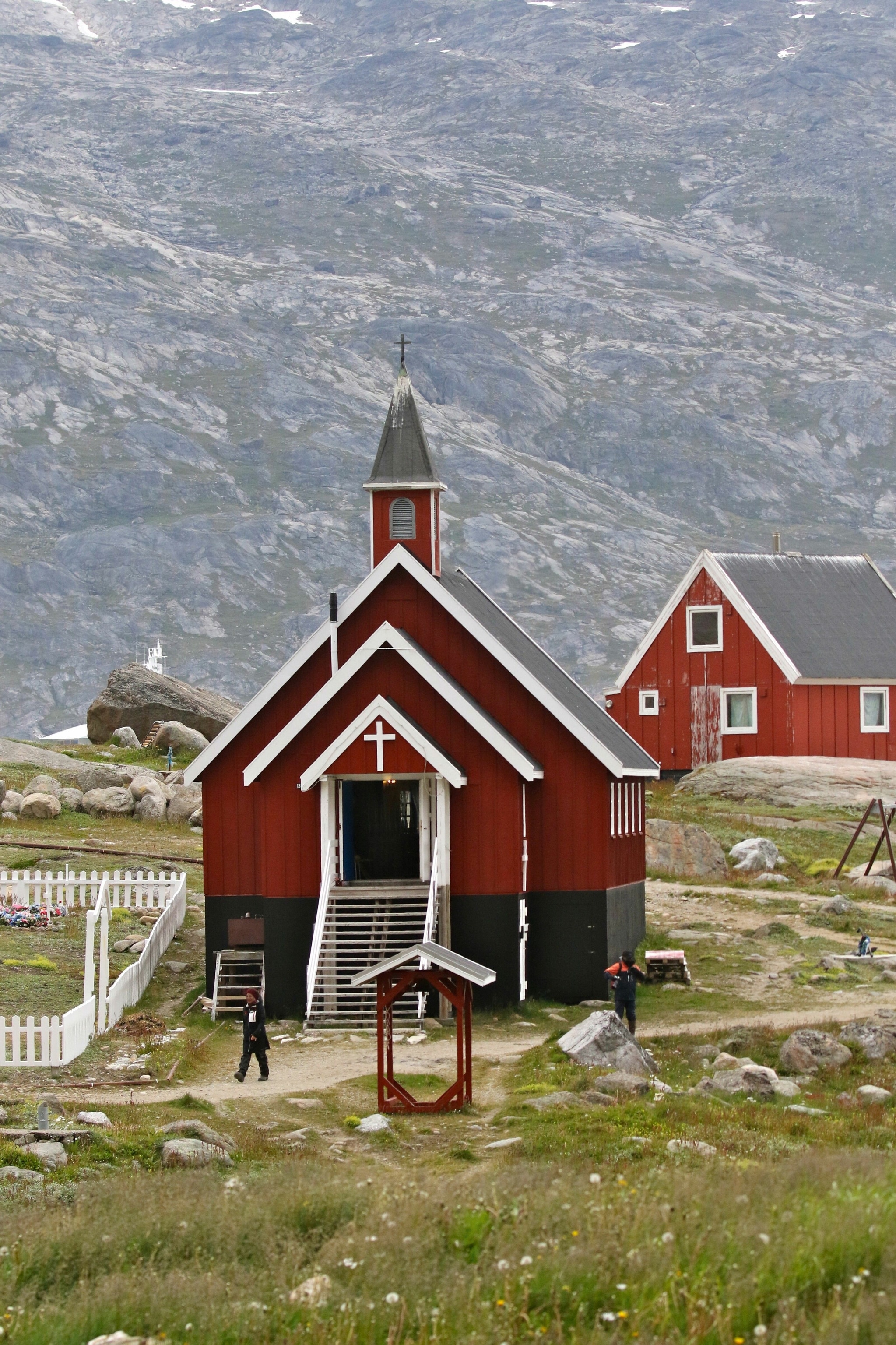
Nearby, the choir is practising in the church, eight villagers in matching white shirts singing about the changing seasons. I take a seat at a red-painted pew while the choirmaster introduces the next hymn. “In winter, it is cold and there is wind,” he explains, “but this song is about summer, which is a wonderful time for us.” He pauses as a thought strikes him, adds a quick “Apart from the mosquitoes”, and then launches into a gentle song that rises and falls like the breeze. An hour later, as I’m clattered to the ground, I discover that the choirmaster sings rather more gently than he plays football. We’ve been challenged to a match, and it’s clear that the villagers of Aappilattoq take the sport seriously. There are determined runs and flying tackles, long-range shots and a much-contested penalty decision. In between breaks to retrieve the ball from the harbour, the villagers score four times; and it could have been more but for some backs-to-the-wall heroics from the ship’s doctor in goal. “Bad luck, Team Ultramarine!” calls Jo consolingly from the sideline, as I traipse off the pitch with no goals and two bruised shins.
The last day comes and it feels the trip has been building to this moment. Like any good dramatist, Alison saves the best for last. “The Greenlandic ice sheet reminds me of my small place in the ecosystem,” she says, and as the throb of the helicopter fades and silence rings, I do find myself feeling quite little. The ice is two miles thick in places and spreads north from here for thousands of miles. Just a handful of people have set eyes on this gargantuan thing. And now, one of them is me.
I climb a hill of glacial scree. This isn’t a landscape of virgin snow; below me the ice is grey with dirt and dust — squint, and it could be sun-baked desert rock. To my right, an ice floe drags inexorably downwards, its surface buckled in folds like charging waves. On the distant fjord, icebergs look like clouds. Greenland is a place where cold can seem hot and solid can seem liquid and where nature destroys or creates, depending on where you’re sitting. “It gives you a different perspective on things, doesn’t it?” says Jo, joining me on a boulder. I nod and we let time pass. “Who knows,” she continues after a while. “If I stay here long enough, perhaps I’ll see the point of sushi.”
Getting there & around
There are no direct flights from the UK to Greenland. Carriers including British Airways, EasyJet, Icelandair and Play offer services from London, Edinburgh and Manchester to Reykjavík in Iceland, where there are connecting flights to Narsarsuaq in southern Greenland, operated by Air Greenland.
Average flight time: 6h.
When to go
Expedition cruises take place between June and August, before the pack ice sets. Daytime temperatures in the south typically range between 5C and 15C, although it can feel colder in the wind. Conditions are very changeable in this region and local fogs and winds can impact on the timings of planned excursions from the ship.
Where to stay
The Ultramarine has en suite cabins accommodating up to five, many with private balconies.
Park Inn by Radisson Reykjavik Keflavik Airport, Iceland. From £140, B&B.
How to do it
Discover the World offers the eight-night South Greenland Expedition Voyage aboard Quark Expeditions’ Ultramarine from £11,008 per person (next departing on 14 and 21 July 2023). Price includes charter flights between Reykjavik and Narsarsuaq; all meals on board; helicopter, boat and kayak excursions; presentations by the expedition team; and post-expedition hotel accommodation. Excludes international flights from the UK to Reykjavík. discover-the-world.com/
Published in the November 2022 issue of National Geographic Traveller (UK)
Follow us on social media
Twitter | Facebook | Instagram


